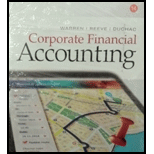
1.
Bonds: Bonds are long-term promissory notes that are represented by a company while borrowing money from investors to raise fund for financing the operations.
Bonds Payable: Bonds payable are referred to long-term debts of the business, issued to various lenders known as bondholders, generally in multiples of $1,000 per bond, to raise fund for financing the operations.
Discount on bonds payable: It occurs when the bonds are issued at a low price than the face value.
Effective-interest amortization method: Effective-interest amortization methodit is an amortization model that apportions the amount of bond discount or premium based on the market interest rate.
To prepare:
2.
A.
To prepare: Journal entry to record first interest payment and amortization of bond discount on December 31, Year 1.
B.
To prepare: Journal entry to record second interest payment and amortization of bond discount on June 30, Year 2.
3.
The amount of total interest expense for Year 1.
Want to see the full answer?
Check out a sample textbook solution
Chapter 11 Solutions
Bundle: Corporate Financial Accounting, Loose-leaf Version, 14th + LMS Integrated for CengageNOWv2, 1 term Printed Access Card
- Sweet Solutions reports net income of $375,000, sales of $6,250,000, and average assets of $850,000. What is the profit margin?arrow_forwardKimberly resides in Jamaica and applied the following rules to losses carried forward in her business. Which rule was incorrectly applied? A.The deduction allowed for prior year losses (PYL) is 50 percent of the net income for the respective year. B.Prior year losses which are not utilized in the current year cannot be applied against net income of subsequent years C.Net income is the total income less all exemptions and allowable deductions excluding the specific losses. D.There is no cap on the number of years for which losses may be carried forward.arrow_forwardPlease explain the solution to this financial accounting problem with accurate explanations.arrow_forward
- What is the rate of return for an investor who pays $963.88 for a three-year bond with an 8.2% coupon paid annually and a face value of $1,000 and sells the bond one year later for $1,016.667?arrow_forwardI need help solving this general accounting question with the proper methodology.arrow_forwardThe canon of _________ advocates that a tax has to be contrived as a mechanism that takes as little as possible out of the pockets of the people and to pay as little as possible over and above what it brings into the public treasury of the state. A.Convenience B.Certainty C.Equity D.Economyarrow_forward
 Excel Applications for Accounting PrinciplesAccountingISBN:9781111581565Author:Gaylord N. SmithPublisher:Cengage Learning
Excel Applications for Accounting PrinciplesAccountingISBN:9781111581565Author:Gaylord N. SmithPublisher:Cengage Learning College Accounting, Chapters 1-27AccountingISBN:9781337794756Author:HEINTZ, James A.Publisher:Cengage Learning,Principles of Accounting Volume 1AccountingISBN:9781947172685Author:OpenStaxPublisher:OpenStax College
College Accounting, Chapters 1-27AccountingISBN:9781337794756Author:HEINTZ, James A.Publisher:Cengage Learning,Principles of Accounting Volume 1AccountingISBN:9781947172685Author:OpenStaxPublisher:OpenStax College Cornerstones of Financial AccountingAccountingISBN:9781337690881Author:Jay Rich, Jeff JonesPublisher:Cengage Learning
Cornerstones of Financial AccountingAccountingISBN:9781337690881Author:Jay Rich, Jeff JonesPublisher:Cengage Learning Financial AccountingAccountingISBN:9781305088436Author:Carl Warren, Jim Reeve, Jonathan DuchacPublisher:Cengage Learning
Financial AccountingAccountingISBN:9781305088436Author:Carl Warren, Jim Reeve, Jonathan DuchacPublisher:Cengage Learning Intermediate Accounting: Reporting And AnalysisAccountingISBN:9781337788281Author:James M. Wahlen, Jefferson P. Jones, Donald PagachPublisher:Cengage Learning
Intermediate Accounting: Reporting And AnalysisAccountingISBN:9781337788281Author:James M. Wahlen, Jefferson P. Jones, Donald PagachPublisher:Cengage Learning





